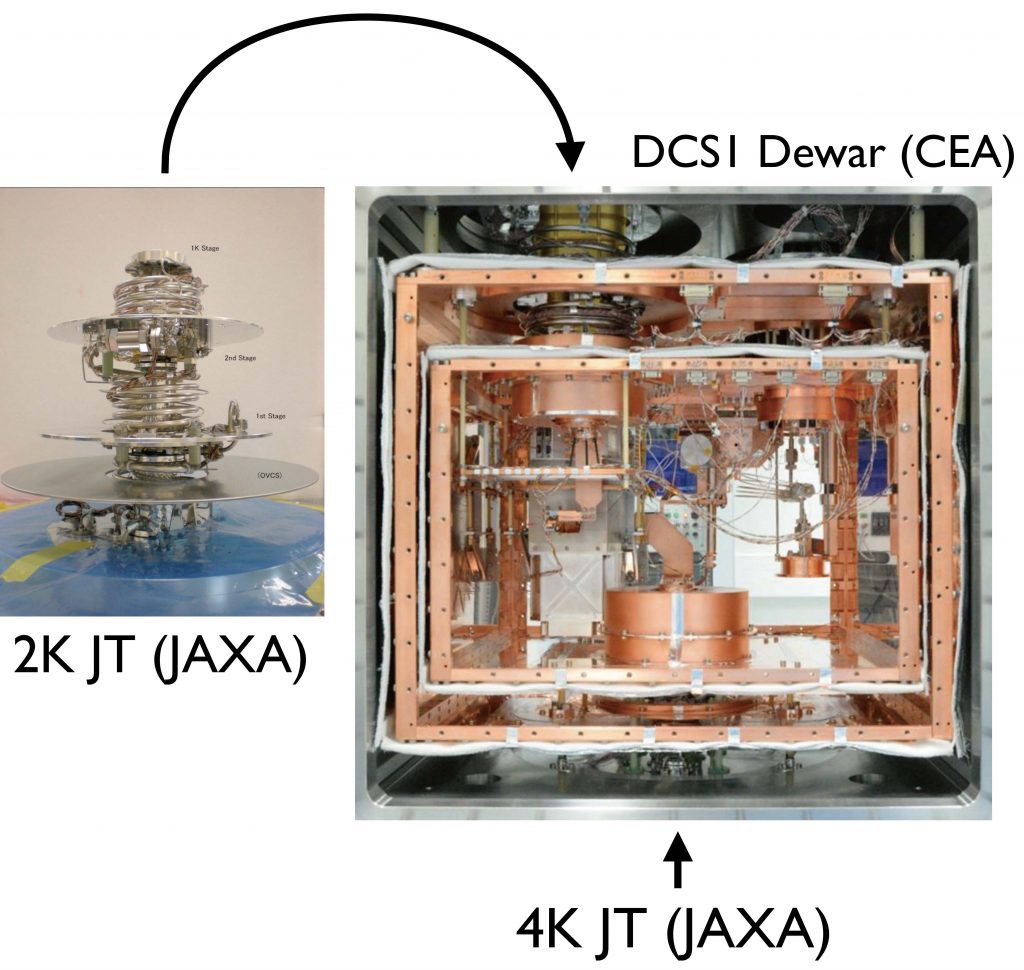
Date.
EDITORIAL
September was a rather busy month for X-IFU. Following the X-IFU Consortium meeting #8 held in Geneva on the second week, the Athena bi-annual conference took place in Palermo on the fourth week. It was the opportunity to present the X-IFU progresses to the community and see in return how the community gets prepared to do science with X-IFU. Several talks highlighted the revolutionary potential of the X-IFU in many science corners of high-energy astrophysics. In the same month, we had to prepare the Instrument Consortia Consolidation (ICC) data pack, to be delivered to ESA on October 1st. The ICC is a rather light process led by ESA by which we expect the two instrument consortia to be formally recognized and appointed. This is an exercise focused mostly on programmatic issues, to ensure that the Athena Lead Funding Agencies (LFAs) are ready to support the overall Athena study phase and related activities (e.g. technology demonstration) until mission adoption. Following the data pack delivery, on October 5th, the ESA executives discussed the content of the ICC data pack with the Athena LFAs. As a very positive outcome, all X-IFU LFAs confirmed to ESA that they are ready to sign letter of endorsement for their proposed contribution. The whole process should be concluded by the next November ESA Science Program Committee. In parallel to the above activities, the CNES project team is consolidating the new Dewar baseline configuration to be submitted to the Instrument Preliminary Requirement Review (I-PRR) (see Alice contribution). On the programmatic front, ESA, JAXA, CNES and IRAP decided jointly to baseline JAXA as the provider of the 2K Joule-Thomson coolers. Finally the whole consortium is now focusing on writing documentation for the IPRR, which is expected to kick-off early February (see Thien contribution).
Didier Barret
X-IFU Principal Investigator
I-PRR, a new milestone for X-IFU
To address the practical preparation of the I-PRR in the frame of this gazette may be very boring for the writer and the readers. It would be more interesting to look back down the path that we have traveled to get here. The I-PRR is the milestone which allows us to present our way to manage the project, our set of requirements, the preliminary definition of the XIFU and the justification of our choices and the expected budgets (and their compliance to requirements). The signature of the X-IFU phase A is the intrinsically hard engineering to be performed because of the combination of an innovative instrument with a very high spectral (energy) resolution together with a cooling system needed to cool the detector to near absolute zero Kelvin. The difficulty is dramatically amplified by different factors: the X-IFU is not the whole spectrometer, the X-IFU doesn’t have a physical unity and is composed of several physical parts. All these units shall be integrated together only at the level of the Payload Module (SIM, Science Instrument Module).
Both the heritage from other projects and the fragmentation of the development lead to implement a bottom-up approach at the beginning of the phase A. This approach has been a major handicap to reach the huge required level of performance and to implement the design-to-mass process imposed by the System constraints of Athena (the lift capability of the launcher).So, we have implemented an additional top-down process by realizing the flowdown of the requirements keeping in mind a balanced sharing of the pain. Optimization is the keyword in the system engineering of the X-IFU. The word optimization should be understood as a global optimization at the X-IFU level and higher levels. It shouldn’t be understood as a combination of locally optimized units. Thanks to the collective effort within the whole Consortium, we did overcome all the difficulties and we can now move with confidence towards the X-IFU-PRR.
Thien Lam Trong
X-IFU Project Manager
A fruitful consortium #8
The eighth X-IFU Consortium meeting was hosted by the University of Geneva. It span from September 10th to 14th. As usual, the meeting consisted of splinter meetings and plenary sessions. Beside the XSAT splinter and some technical meetings on JAXA coolers and on the Detector Cooling System, one splinter meeting was devoted to the preparation of the Instrument Preliminary Requirement Review (IPRR) documentation. The X-IFU Consortium Board met twice to prepare the Instrument Consortia Consolidation documentation, and iterated on the critical technologies and designs to be demonstrated before adoption.
The plenary sessions lasted two full days, giving sufficient time to review the status of the Athena mission, the baseline configuration of the instrument, and the status of all X-IFU subsystems. The last morning session of the meeting focused on science and performance related topics, and was concluded by presentations on the way forward to the IPRR. Let me take this opportunity to thank again the University of Geneva, and more particularly Enrico Bozzo, for hosting so smoothly the whole meeting in the beautiful city of Geneva. The next Consortium meeting will be in Grenoble, hosted by CEA-SBT.
Didier Barret
X-IFU Principal Investigator
A constructive Critical Design Review of the Focal Plane Assembly Demonstration Model
SRON organized the Critical Design Review of the FPA-DM on September 17th-18th 2018. These two days were the opportunity to discuss the evolution of the design. FPA DM design is amply extensively described in the documents provided to the review group and most significant points were presented during the review. Let us remind here that the FPA-DM is a very early model of the FPA which has not the ambition to be fully representative of the flight model, especially the very end performance. However, thanks to the FPA-DM, it will be possible to demonstrate many other parameters, especially the behavior of the FPA when submitted to stringent environment. This will contribute to lower the technical risks on subsequent EM and FM models.
Françoise Douchin
Instrument engineering manager
Hervé Geoffray
Detection chain expert
A new structure for the Dewar
The Dewar of X-IFU is a closed cryostat whose main function is to thermally insulate and actively cool the FPA and the detectors at the required temperatures, from the SIM ambient temperature. This implies to provide mechanical support not only to the FPA, but also to the cryogenic chain units requiring proximity to the cold parts (sub-K cooler, mechanical coolers cold heads and some of their compressors). Another function is to provide protection to sensitive cold parts from the outer environment.
From the EMC point of view, the Dewar participates to the shielding of the FPA signals and the low temperature measurement signals. This implies to gather in a single Faraday cage the Dewar outer vessel and the electronics hosting the reading of these signals (WFEEs, RTUs), and requires that these boxes be mechanically supported in the same assembly as the Dewar, with EMC continuity. The limitation of FPA harness length for electrical reasons (1.5 m) also acts for a Dewar carrying the WFEEs. In total, the Dewar has to carry roughly 120 kg of cryogenic chain units and 50 kg of detection chain and sensitive signals reading boxes.
Furthermore, the Dewar protects detectors and thermal filters from contamination, and the latter from acoustic loads, on ground and during launch, and so includes a vacuum-tight vessel compatible with launch loads.
Combining the functions of vacuum-tightness and mechanical support on the structure of the outer vessel has reached a technical limit with last summer evolution of the Dewar thermal architecture. With the addition of a passive shield cooled at 200 K via SIM radiators (IPCS), and the resulting increase of Dewar mass and volume, the mechanical design became marginal with respect to modal and strength criteria, within the allocated mass.
One introduced a concept of a new truss-kind structure, external to the closed vessel and dedicated to mechanical support, in order to alleviate the outer vessel. Several options are possible, according to units deported from the vessel to the truss: either only warm boxes, or also PT compressors (beneficial for microvibration limitation), or also PT compressors plus coolers cold heads (this last one complicating the definition of the coolers flange interface with outer vessel).
A trade-off between the three combinations of truss structure and lightened tight vessel, all satisfying stiffness and strength constraints, is conducted with respect to a mass criterion, and shall soon bring out the Dewar structure baseline for I-PRR.
Alice Pradines
Dewar manager
Focus on : Jaxa’s contributions to X-IFU
As their main contribution, JAXA’s will provide two types of Joule-Thomson (JT) coolers, 2K JT and 4K JT, and their drive electronics. JT coolers utilize JT process which is an expansion of gas with enthalpy conserved. Ideal gas will not change its temperature with this process, but real gas will. At room temperature, Helium gas gets warmer by the process but when it gets colder than its “inverse temperature” (about 55 K for Helium at a 0-pressure limit), the temperature is decreasing. Therefore, JT coolers requires pre-cooling by other cooling mechanism. Concerning the X-IFU pulse-tube coolers provided by ESA, they will pre-cool the Helium gas to about 15K. The vapor pressure will decrease very rapidly below 4 K and 2 K for 4He and 3He respectively, which determines the lowest temperature achieved by JT coolers. JT coolers consists of JT orifice which separates Helium of different pressures and through which Helium flows and expands, compressors which create pressure difference and Helium flow, and heat exchangers where the circulating Helium gas is effectively pre-cooled.
JAXA started development of space mechanical coolers in 1980’s with cooperation with Sumitomo Heavy Industries. So far two 4K JT coolers have flown in orbit: in the SMILES mission on ISS, and in the SXS mission on Hitomi (ASTRO-H). A 2K JT cooler was originally developed for the infrared mission, SPICA and will also be used for the CMB mission, LiteBIRD. The one for X-IFU requires longer lifetime than all of those missions. We consider that the present JT coolers can satisfy the 4.25 lifetime requirement of Athena, however it has not been proved by tests. Thus JAXA is conducting further lifetime tests and developments.
The Japanese X-IFU members consists of a team of scientists and an engineer from JAXA and two Japanese universities. With the expertise of the Hitomi SXS, they will also contribute to the cooling system design, calibration of the instrument, and science. Backup cryogenic readout SQUIDs are also being developed in collaboration with SRON and VTT
Kazuhisa Mitsuda
X-IFU Co-investigator
Bio : Dr. Kazuhisa Mitsuda
Dr. Kazuhisa Mitsuda is an X-IFU consortium board member and he is leading the Japan’s contribution. He is a professor at Institute of Space and Astronautical Science of JAXA located in Sagamihara, and a professor at Graduate School of Science, University of Tokyo. He is appointed Program Director of Space Science at ISAS. He was the JAXA PI of the SXS onboard Hitomi. The recent main objectives of his research group in astrophysics are the soft X-ray diffuse background and the hot interstellar medium. They extended their analyses of Suzaku data to constrain keV-range emission from dark matter in the halo of our Galaxy. They also develop TES X-ray microcalorimeters and the readout electronics. They deployed an energy-dispersive X-ray spectrometer using a TES array for a scanning transmission electron microscope at National Institute of Material Science in Tsukuba for X-ray micro analysis.





 Facebook
Facebook Twitter
Twitter Youtube
Youtube